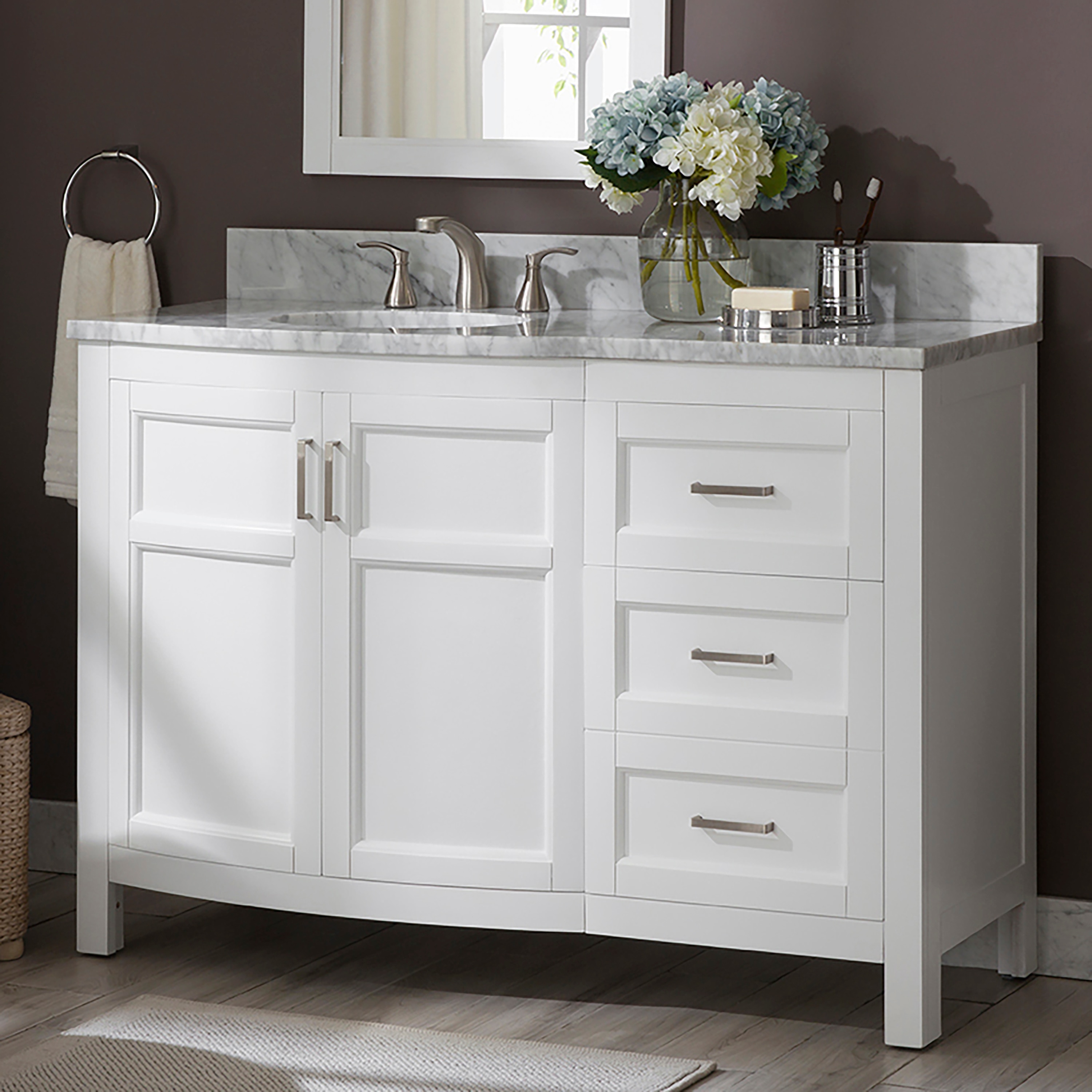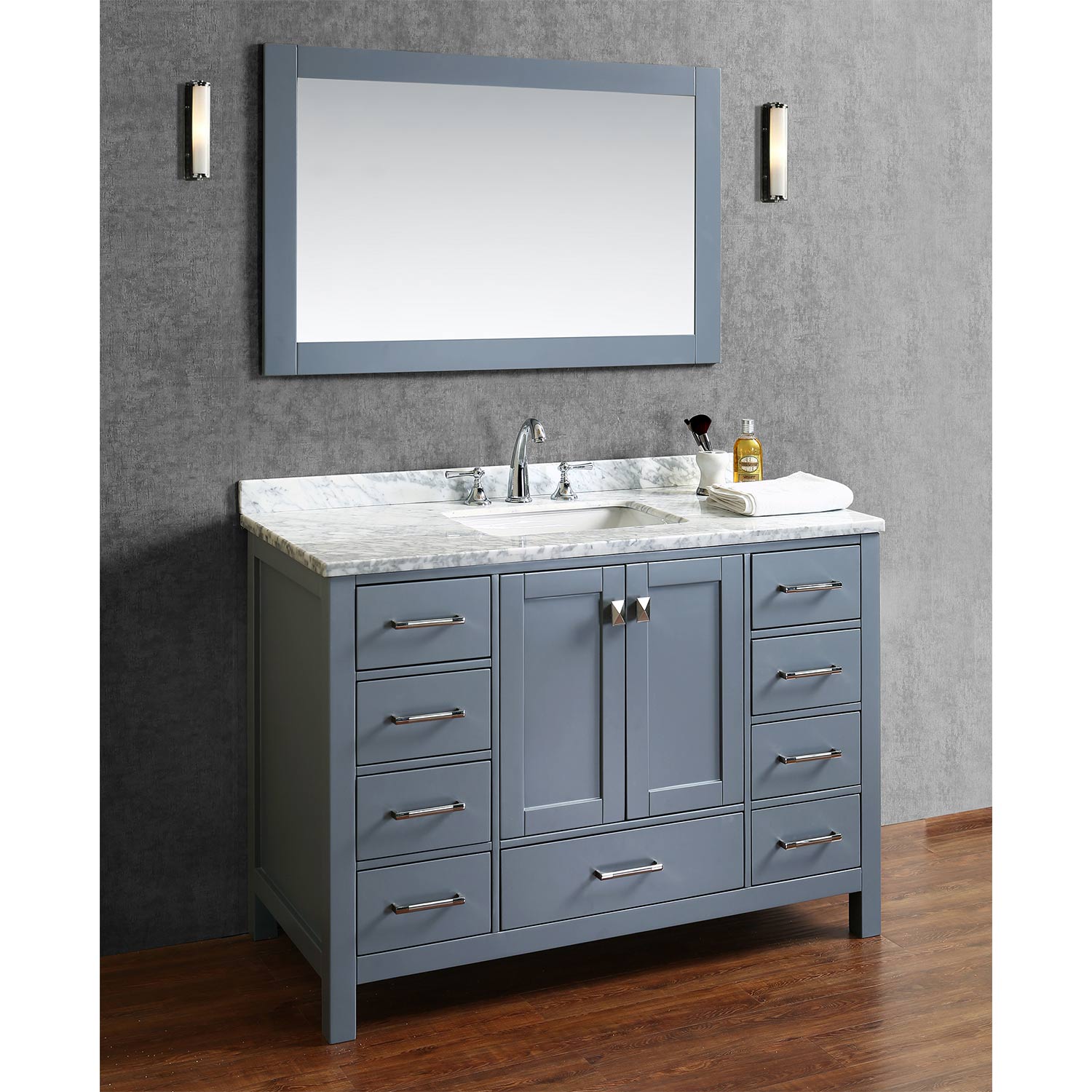Understanding the “48 Left Offset Bathroom Vanity Top”

A “48 Left Offset Bathroom Vanity Top” is a type of vanity top that is designed to be installed with the sink bowl positioned to the left of the center of the vanity base. This offset design allows for a more functional and aesthetically pleasing arrangement of the vanity and sink within a bathroom space.
Understanding the “Left Offset” Design
The term “left offset” refers to the placement of the sink bowl relative to the center of the vanity base. In a standard bathroom vanity top, the sink bowl is typically centered. However, a left offset vanity top shifts the sink bowl to the left, creating an asymmetrical design. This offset configuration can be advantageous in various bathroom layouts, particularly when space optimization or a specific aesthetic is desired.
Dimensions of a Standard Bathroom Vanity Top and How a 48″ Left Offset Top Differs
Standard bathroom vanity tops typically range in size from 24″ to 72″ in width. A 48″ left offset vanity top maintains a standard width of 48″, but the sink bowl is positioned to the left of the center. This offset typically results in a sink bowl placement that is approximately 12″ to 18″ from the left edge of the vanity top, depending on the specific design.
Examples of Bathroom Vanity Styles That Could Incorporate a 48″ Left Offset Top
A 48″ left offset vanity top can be incorporated into a wide variety of bathroom vanity styles, including:
- Traditional: A traditional vanity style typically features ornate details, such as carved legs, decorative hardware, and a classic design aesthetic. A 48″ left offset vanity top can complement this style by providing a unique and functional element within the overall design.
- Modern: Modern vanity styles are characterized by clean lines, minimalist designs, and contemporary materials. A 48″ left offset vanity top can enhance the modern aesthetic by adding a touch of asymmetry and visual interest.
- Contemporary: Contemporary vanity styles often feature a combination of modern and traditional elements, creating a transitional look. A 48″ left offset vanity top can seamlessly blend into this style, providing a balanced and functional design element.
- Transitional: Transitional vanity styles bridge the gap between traditional and modern designs. A 48″ left offset vanity top can enhance the transitional style by adding a unique and functional element that complements the blend of classic and contemporary features.
Design Considerations for a 48″ Left Offset Bathroom Vanity Top

A 48″ left offset bathroom vanity top offers a unique and functional design element for bathrooms. Its offset design allows for greater flexibility in bathroom layout and maximizes space utilization. This section explores the design considerations associated with incorporating a 48″ left offset bathroom vanity top into your bathroom design.
Advantages and Disadvantages, 48 left offset bathroom vanity top
The 48″ left offset bathroom vanity top presents both advantages and disadvantages, which should be carefully considered during the design process.
- Advantages:
- Increased Counter Space: The offset design provides more counter space on the left side, allowing for a larger sink and ample room for toiletries, decorative items, and other bathroom necessities.
- Improved Accessibility: The offset design can be beneficial for individuals with mobility issues, as it provides more space for maneuvering around the vanity.
- Unique Aesthetic: The offset design adds a distinctive and modern touch to the bathroom, creating a visually appealing and functional space.
- Disadvantages:
- Limited Sink Options: The offset design may limit the selection of sink styles, as it requires a sink that fits the specific dimensions of the vanity top.
- Potential Space Constraints: In smaller bathrooms, the offset design may require careful planning to ensure adequate space for movement and access to other fixtures.
- Higher Cost: Offset vanity tops are often more expensive than standard vanity tops due to their unique design and construction.
Design Tips for Small Bathrooms
Incorporating a 48″ left offset vanity top into a small bathroom requires careful planning to maximize space and maintain a balanced aesthetic.
- Optimize Wall Space: Utilize the wall space above the vanity to install open shelves or a medicine cabinet, providing additional storage without taking up valuable floor space.
- Mirrors: Utilize mirrors strategically to create the illusion of more space. Consider a large mirror above the vanity or a series of smaller mirrors to reflect light and visually expand the bathroom.
- Lighting: Employ a combination of overhead and task lighting to illuminate the vanity area effectively. Consider installing under-cabinet lighting to enhance visibility and create a more inviting atmosphere.
- Color Palette: Opt for light and neutral colors to create a sense of spaciousness. Use bright accents or decorative elements to add visual interest without overwhelming the small space.
Bathroom Layout with a 48″ Left Offset Vanity Top
Consider a bathroom layout with a 48″ left offset vanity top placed against the left wall. The offset design allows for a larger sink and ample counter space on the left side. The remaining space can be utilized for a toilet and a shower or bathtub, depending on the bathroom size and preferences.
Example: A small bathroom with a 48″ left offset vanity top can feature a toilet placed directly opposite the vanity, with a walk-in shower or a compact bathtub positioned in the remaining space. This layout maximizes space utilization and provides a functional and visually appealing bathroom design.
Installation and Functionality of a 48″ Left Offset Bathroom Vanity Top

Installing a 48″ left offset bathroom vanity top requires careful planning and execution to ensure proper functionality and aesthetics. This section delves into the installation process, plumbing considerations, and steps to guarantee optimal performance of the sink and faucet.
Installation Process
Installing a 48″ left offset bathroom vanity top involves several steps, ensuring proper alignment, securing the top, and connecting plumbing.
- Preparation: Begin by clearing the area around the vanity base and ensuring the floor is level. If the vanity base is not already installed, follow the manufacturer’s instructions for its assembly and placement.
- Placement and Alignment: Carefully position the vanity top on the base, ensuring it is centered and aligned with the wall. Use a level to ensure the top is perfectly horizontal.
- Securing the Top: Most vanity tops come with mounting brackets or clips that secure them to the base. Install these according to the manufacturer’s instructions. For heavier tops, additional support may be required.
- Plumbing Connection: Connect the faucet to the vanity top’s pre-drilled holes. Ensure the faucet is securely fastened and that the supply lines are connected to the water shut-off valves.
Plumbing Considerations
The left offset design necessitates specific plumbing considerations to ensure proper water supply and drainage.
- Drain Location: The drain opening for a left offset vanity top will be located on the left side of the sink. This requires the drain pipe to be routed accordingly, potentially requiring adjustments to existing plumbing.
- Faucet Supply Lines: The hot and cold water supply lines for the faucet will also need to be routed to the left side of the vanity top. This may involve extending existing supply lines or installing new ones.
- P-Trap Installation: The P-trap, which prevents sewer gases from entering the home, needs to be properly installed and secured. It is crucial to ensure the P-trap is correctly sized and positioned to avoid any potential clogs or leaks.
Functionality of the Sink and Faucet
After installation, it is essential to verify the proper functionality of the sink and faucet.
- Sink Drainage: Test the sink’s drainage by filling it with water and allowing it to drain. Observe for any leaks or slow drainage, which may indicate issues with the drain pipe or P-trap.
- Faucet Operation: Turn the faucet on and off to ensure it operates smoothly and without leaks. Check the hot and cold water flow to confirm they are functioning correctly.
- Faucet Sprayer (if applicable): If the faucet has a sprayer, test its functionality and ensure it retracts properly.
